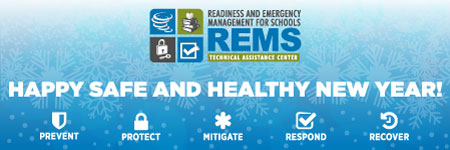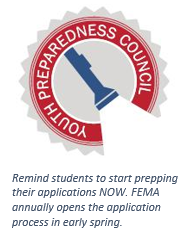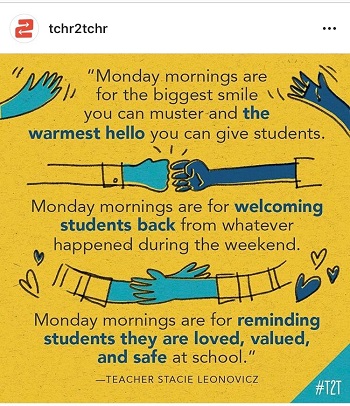|

This quarterly newsletter details information, updates, and free resources from the REMS TA Center for all stakeholders with a role in school and higher ed preparedness.
Topical Resource Feature
This section of our newsletter features resources relevant to seasonal trends, current events, and other timely topics in the field.
Understanding Food Safety: Developing Plans to Protect the Whole School Community
The recent outbreak of E. Coli infections that has been linked to romaine lettuce is a timely reminder that food contamination can be unintentional from biological (e.g., bacteria, viruses, parasites), chemical (allergens, pesticides, sanitizers, food additives), or physical (e.g., plastic, glass, metal) agents. Foodborne illness outbreaks in school settings can result from improper food handling at any stage and staff not being vigilant about food safety practices. By developing a Food Contamination Annex as a part of school and school district emergency operations plans (EOPs) and by incorporating food safety practices and standards, education agencies can determine how they will protect food products and address food contamination before, during, and after a food contamination incident occurs.
 To support schools and school districts with their planning efforts, the REMS TA Center offers an online course titled School EOPs In-Depth: Developing a Food Contamination Annex which can be used for independent learning, and a downloadable specialized training package on Developing a Food Contamination Annex which can be used to instruct others. Additionally, we hosted a Webinar on Food Safety and Emergencies: Preparedness Activities for Schools with the U.S. Department of Agriculture’s (USDA) Food and Nutrition Service (FNS) and the Hampden-Wilbraham Regional School District. FNS’ Office of Food Safety offers an educational video series and other
resources on food safety to support FNS program operators—such as schools—in protecting people from foodborne illness. Additionally, USDA’s Food Safety and Inspection Service offers a Back to School Toolkit to prevent foodborne illness. For additional resources on contaminated food outbreaks, visit our Topic-Specific Web Page (click Contaminated Food Outbreaks on this page) or join in on the conversation online via our related Community of Practice (CoP) forum.
To support schools and school districts with their planning efforts, the REMS TA Center offers an online course titled School EOPs In-Depth: Developing a Food Contamination Annex which can be used for independent learning, and a downloadable specialized training package on Developing a Food Contamination Annex which can be used to instruct others. Additionally, we hosted a Webinar on Food Safety and Emergencies: Preparedness Activities for Schools with the U.S. Department of Agriculture’s (USDA) Food and Nutrition Service (FNS) and the Hampden-Wilbraham Regional School District. FNS’ Office of Food Safety offers an educational video series and other
resources on food safety to support FNS program operators—such as schools—in protecting people from foodborne illness. Additionally, USDA’s Food Safety and Inspection Service offers a Back to School Toolkit to prevent foodborne illness. For additional resources on contaminated food outbreaks, visit our Topic-Specific Web Page (click Contaminated Food Outbreaks on this page) or join in on the conversation online via our related Community of Practice (CoP) forum.
|
|
Functional Resource Feature
This section of our newsletter features resources relevant to seasonal trends, current events, and other timely topics in the field.
An Overview of Our ENHANCED Publications Web Page
One of the most common inquiries that we receive is requests for publications and guidance documents that can inform state, territorial and local planning. To respond to these requests, in 2018, we invested time in updating our Publications page, which features resources we produced in collaboration with Federal partners and practitioners in the field. The page features the following resource types:
- Guidance Documents. Align and build upon years of emergency planning work by the Federal government and may be used to develop and revise high-quality EOPs.
- Sample Annexes. Specify policies and procedures, as well as responsibilities and actions that are taken before, during, and after an emergency event.
- Fact Sheets. Explore key topics in school and higher ed preparedness.
- Resource Lists. Offer supplemental reading guides to accompany Webinars and virtual meetings.
- News & Updates from the REMS TA Center. Distributed on a quarterly basis to highlight new tools, resources, and trends in the field.
- REMSExpress Articles. Highlight emerging issues in emergency operations planning.
- Lessons Learned Articles. Provide brief descriptions of actual school emergencies.
- Success Stories Articles. Offer brief profiles of specific activities, tools, or strategies developed or utilized by school districts or IHEs.
- Helpful Hints Articles. Provide a quick overview of school emergency preparedness topics that are frequently the subject of TA inquiries.
- Other Publications. Toolkits, informational sheets, lists, FAQ sheets, work sheets, and tip sheets.
To access this page, click the Technical Assistance tab, select Resources, and then scroll down until you see Publications. ED and the REMS TA Center recommend that practitioners visit this page in combination with our Topic-Specific Resources section throughout the year as you respond to seasonal (e.g., seasonal flu and winter weather hazards) and other emergencies.
|
|
Help Desk Request Snapshot
This section of our newsletter highlights a noteworthy topic among technical assistance inquiries received from the field during the last quarter.
A Focus on Youth Preparedness
 Youth preparedness is important because it can help enhance whole school community preparedness. Education agencies throughout the nation understand the value of youth preparedness, and several schools have recently requested technical assistance on how they can empower their students—beyond regular training and drills—to be better prepared for emergencies. The K-12 community has access to numerous programs that teach children and youth valuable, practical skills to help them and their families, schools, and communities before, during, and after an emergency, build a culture of preparedness, and train the next generation of emergency management practitioners.
Youth preparedness is important because it can help enhance whole school community preparedness. Education agencies throughout the nation understand the value of youth preparedness, and several schools have recently requested technical assistance on how they can empower their students—beyond regular training and drills—to be better prepared for emergencies. The K-12 community has access to numerous programs that teach children and youth valuable, practical skills to help them and their families, schools, and communities before, during, and after an emergency, build a culture of preparedness, and train the next generation of emergency management practitioners.
The REMS TA Center hosted a joint Webinar with the Federal Emergency Management Agency (FEMA) and Lincoln County School District in Oregon that focuses on enhancing school emergency management through youth engagement and preparedness. It focuses on FEMA’s Teen CERT program and how schools may use it to engage youth in school emergency management planning. FEMA’s Teen CERT program is adapted from their adult CERT program to equip high school students with basic response skills and an understanding of emergency preparedness concepts.
Additional programs of note for various age levels include:
- Elementary/Middle: Pillowcase Project, which is an interactive preparedness program with a mission to increase awareness and understanding of natural hazards among youth ages 8 to 11. It teaches safety, emotional coping skills, and personal preparedness.
- High School: Youth Preparedness Council, which provides input on strategies, initiatives, and projects to FEMA staff and complete local and national disaster preparedness projects.
- Higher ed: National Youth Preparedness Initiative (MyPI National), which builds upon Teen CERT with two additional components that include certification in CPR and AED usage and completion of a comprehensive family and community service project.
You can learn more about strategies to start, assess, and maintain your own local program in the publication Youth Preparedness: Implementing a Community-Based Program. Search for general youth preparedness resources from all federal partners—based on geographic location and student grade level—via the Youth Preparedness Catalogue: Disaster Preparedness Education Programs and Resources.
We would love to hear success stories of how you are training your students to be better prepared! Share them via our Community of Practice of Twitter using the #PrepareathonforSchools hashtag.
|
|
#REMSontheRoad Spotlight
This section of our newsletter features details specific to the REMS TA Center Training by Request (TBR) and #REMSontheRoad Program.
 Introducing the NEW REMS TA Center Extension Training (EXT) Format
Introducing the NEW REMS TA Center Extension Training (EXT) Format
As the REMS TA Center works to continually enhance the level and type of services we provide to the field, we are excited to introduce our new training format—the Extension Training (EXT). The EXT is a 1.5-hour training curriculum that can be added as a supplement to our existing live training offerings. Our first EXT, Conducting K-12 Site Assessments with SITE ASSESS, is available for request today! During this EXT, participants will learn about SITE ASSESS, a mobile application designed to support education agencies with examining the safety, security, accessibility, and emergency preparedness of a school building and grounds. Training participants will walk away with an understanding of the importance of site assessments as a school emergency preparedness activity, an overview of the secure mobile app and its features, and shared strategies for using the app to conduct K-12 site assessments collaboratively.
Is your school, school district or institution of higher education interested in requesting our new EXT training, or another live training for your education agency? Visit our TBR Web page to access details about the current training topics and remember that very training we offer is 100% free! Our schedule is currently open to plan new trainings through September 2019, although our calendar is filling up fast!
Curious about whether a training is already scheduled in your area? Check out upcoming TBRs we have scheduled across the country by accessing the #REMSontheRoad forums on the REMS TA Center Community of Practice (CoP) or by viewing the graphic featured here. You can also share your experiences at any time with @remstacenter via Twitter using the #REMSontheRoad hashtag.
|
|
Virtual Networking Corner
This section of our newsletter features highlights from our interactions with the field via Twitter, the CoP, and other virtual events and networking platforms.
Exclusive Resources to be Featured on the CoP in 2019
Are you a member of our CoP? If you are, now is a good time to get more engaged, and if you’re not, it’s a good time to join! This year, we will be featuring a sneak-peak of soon-to-be-released REMS TA Center resources for CoP members only. Stay tuned for additional details about the NEW forum we will be creating to feature these exclusive resources for our more than 2,000 members and spread the word to your colleagues.
Top @remstacenter Tweet for the Quarter
Are you on Twitter? Follow the REMS TA Center via @remstacenter plus check out our top tweet for the past quarter below, which highlights a post shared by a member of @Teacher2Teacher, a virtual community of teachers. Keep this message in mind and share it regularly as you work with local education agencies and community partners in your states, territories and localities to help ensure safe and supportive learning environments.
#School Leaders: Share this message with ALL staff every Monday to reinforce a positive #schoolclimate & a safe and supportive learning environment. Remember, it often only takes 1 trusted adult in the building to make students feel safe and supported. #schoolsafety #safeschools https://twitter.com/MrsSandersTeach/status/1069594276382818304

|
If you have any questions or need additional assistance, please contact the REMS TA Center at  1-855-781-REMS [7367] or 1-855-781-REMS [7367] or  via email at info@remstacenter.org. via email at info@remstacenter.org. |
|

